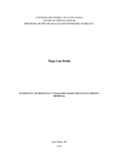| dc.creator | Badin, Tiago Luis | |
| dc.date.accessioned | 2018-08-17T20:50:19Z | |
| dc.date.available | 2018-08-17T20:50:19Z | |
| dc.date.issued | 2018-02-27 | |
| dc.identifier.uri | http://repositorio.ufsm.br/handle/1/14069 | |
| dc.description.abstract | The Brazilian rainforests, mainly the Amazon, store in their biomass a large part of the global carbon stock, as a result of deforestation and degradation there has already been a considerable commitment, catalyzing the release of greenhouse gases into the atmosphere, aggravating the effects of global warming. In this context, the objective of this work was to estimate the above - ground biomass from data from airborne laser in Amazon rainforest. We used inventory data to calculate the biomass above the soil, values calculated through the model adjusted by Chave et al. (2015) adapted for tropical regions. Subsequently, the variables from the FUSION 3.6 software, derived from the airborne laser survey, were pre-selected using the Stepwise method. In the modeling, six models were tested: Linear, multiplication, exponential, parabola, polynomial of degree three and polynomial of degree four, where the variables Elev.CV, Elev.P99, Elev.MAD.mode and Elev.L3 from the laser composed the final model The best model was the polynomial of degree four, without intercept, which obtained coefficient of determination (R²) 0.76, standard error of estimate (Syx) 26.99, coefficient of variation (CV) 36,29, efficiency (E) 0.99, and absolute trend index (BIAS) -0.00005, and was therefore selected by the statistical criteria, later validated by the student's t-test. Thus, modeling with the inventory data related to LiDAR metrics proved to be efficient in the characterization of the tropical forest, showing that it is possible to use this technology to obtain estimates of above-ground biomass in tropical forests. | eng |
| dc.language | por | por |
| dc.publisher | Universidade Federal de Santa Maria | por |
| dc.rights | Attribution-NonCommercial-NoDerivatives 4.0 International | * |
| dc.rights.uri | http://creativecommons.org/licenses/by-nc-nd/4.0/ | * |
| dc.subject | Amazônia | por |
| dc.subject | Laser aerotransportado | por |
| dc.subject | Modelagem | por |
| dc.subject | Regressão linear | por |
| dc.subject | AGB | por |
| dc.subject | Airborne laser | eng |
| dc.subject | Modeling | eng |
| dc.subject | Linear regression | eng |
| dc.subject | AGB | eng |
| dc.title | Estimativa de biomassa utilizando dados lidar em floresta tropical | por |
| dc.title.alternative | Biomass using lidar data in tropical forest | eng |
| dc.type | Dissertação | por |
| dc.description.resumo | As florestas tropicais brasileiras, principalmente a Amazônia, armazenam na sua biomassa grande parte do estoque global de carbono, em virtude do desmatamento e degradação já houve um comprometimento considerável, catalisando a liberação de gases efeito estufa na atmosfera agravando os efeitos do aquecimento global. Neste contexto, o objetivo deste trabalho foi estimar a biomassa acima do solo a partir de dados provenientes de laser aerotransportado em floresta tropical amazônica. Utilizou-se dados de inventário para calcular a biomassa acima do solo, valores calculados por intermédio do modelo ajustado por Chave et al. (2015) adaptado para regiões tropicais. Posteriormente, as variáveis oriundas do software FUSION 3.6, provenientes do levantamento a laser aerotransportado, foram pré-selecionadas utilizando o método Stepwise. Na modelagem foram testados seis modelos: Linear, multiplicação, exponencial, parábola, polinômio de grau três e polinômio de grau quatro, onde as variáveis Elev.CV, Elev.P99, Elev.MAD.mode e Elev.L3 oriundas do laser compuseram o modelo final. O melhor modelo foi o polinomial de grau quatro, sem intercepto, que obteve coeficiente de determinação (R²) 0,76, erro padrão da estimativa (Syx) 26,99, coeficiente de variação (CV) 36,29, eficiência (E) 0,99, e índice de tendência absoluta (BIAS) -0,00005, e, portanto, foi selecionado pelos critérios estatísticos, posteriormente validado pelo teste t de student. Com isso, a modelagem com os dados do inventário relacionados a métricas LiDAR mostraram-se eficientes na caracterização da floresta tropical mostrando que é possível utilizar essa tecnologia para obter estimativas da biomassa acima do solo em florestas tropicais. | por |
| dc.contributor.advisor1 | Pereira, Rudiney Soares | |
| dc.contributor.advisor1Lattes | http://lattes.cnpq.br/9479801378014588 | por |
| dc.contributor.referee1 | Silva, Emanuel Araújo | |
| dc.contributor.referee1Lattes | http://lattes.cnpq.br/2765651276275384 | por |
| dc.contributor.referee2 | Pegoraro, Antoninho João | |
| dc.contributor.referee2Lattes | http://lattes.cnpq.br/7214337305907407 | por |
| dc.creator.Lattes | http://lattes.cnpq.br/1698124445731124 | por |
| dc.publisher.country | Brasil | por |
| dc.publisher.department | Recursos Florestais e Engenharia Florestal | por |
| dc.publisher.initials | UFSM | por |
| dc.publisher.program | Programa de Pós-Graduação em Engenharia Florestal | por |
| dc.subject.cnpq | CNPQ::CIENCIAS AGRARIAS::RECURSOS FLORESTAIS E ENGENHARIA FLORESTAL | por |
| dc.publisher.unidade | Centro de Ciências Rurais | por |



